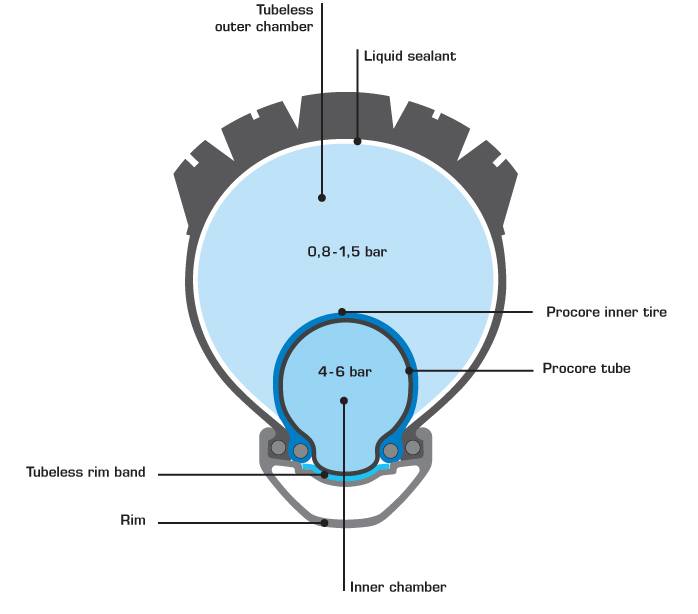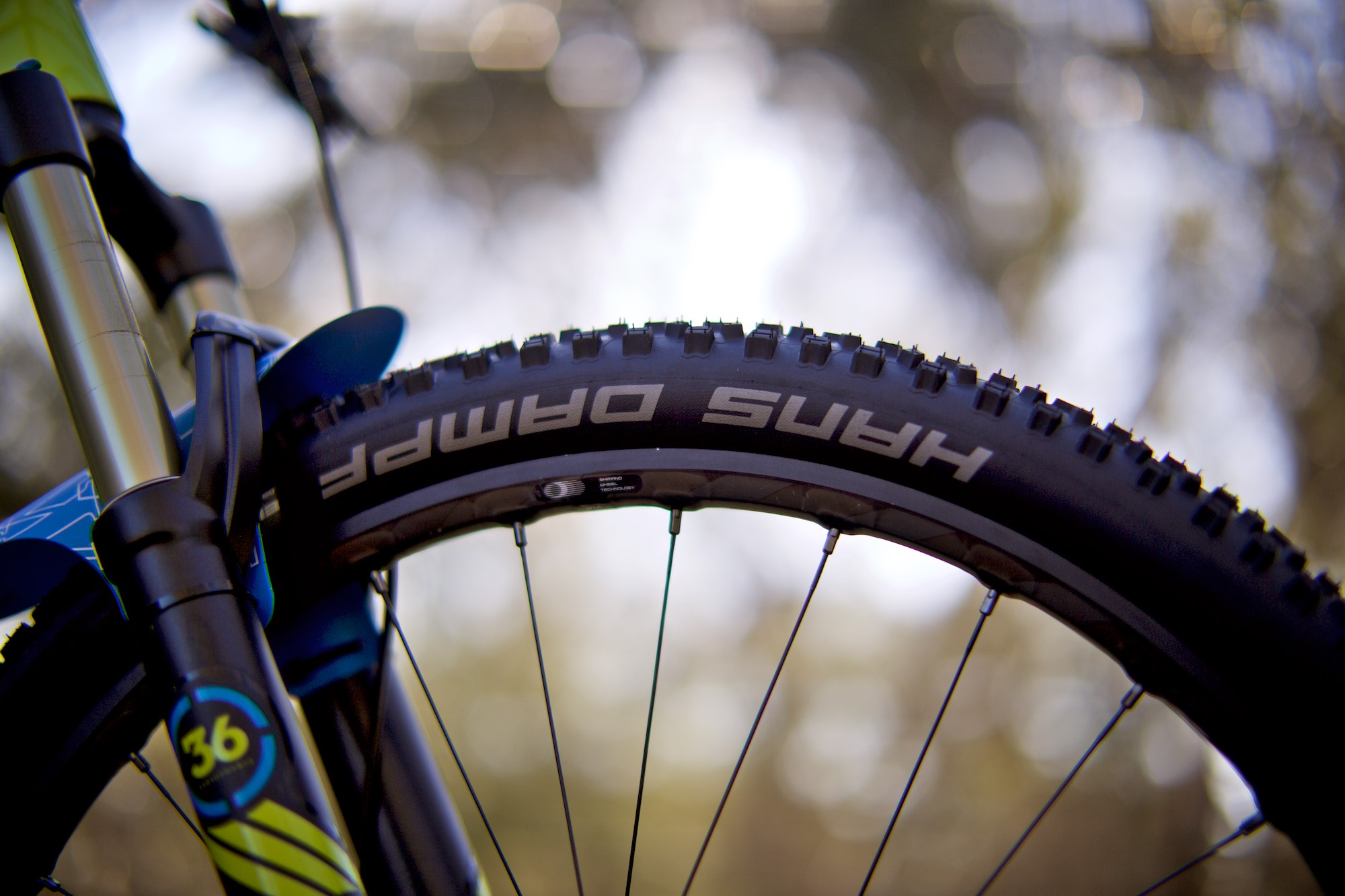The biggest thing to happen to your wheels since tubeless is the development of Schwalbe Procore. There is good reason this system comes at such a high price – the amount of research and development in getting it right would have been huge. In our review we aim to determine if it achieves all that it sets out to do, but most importantly ascertain what type of bike and rider will benefit from this technology the most.
Developed by German tyre gurus Schwalbe in conjunction with component and wheel manufacturer Syntace, Procore is a special dual chamber system that fits inside regular tyres and onto regular rims (some limitations do apply).
We’ll be putting Procore to a test over a couple months, here is our initial thoughts after fitment and a couple weeks riding.
[divider]What is it?[/divider]
Procore is a dual air chamber system that fits inside the tyre. It’s compatible with any brand of tubeless compatible tyre, in three wheel sizes (26″, 27.5″/650B and 29″) and will fit any rim (even non-tubeless rims) with a minimal internal width of 23mm. You’ll need tyres at least 2.25″ (but we found out bigger is better) wide and rims with valve stem depth no more than 20mm.
It’ll add about 420 grams to an existing tubeless wheel set, and retails for around $400.

[divider]What does it aim to do? [/divider]
In a nutshell, Procore aims to reap all the traction and control benefits of running super-low tyre pressures, without the usual downsides. Motorcycles use a similar technology, the theory certainly stands up well on paper.
Less chance of tyre roll/burping: The inner chamber locks the tyre bead to the rim.
Reduced chance of rim damage: With the high-pressue inner chamber, your rim is protected from impacts.
Less chance of tyre pinching: The cushioning of the inner chamber makes it near impossible to pinch your tyre against the rim.
[divider]Who is it for?[/divider]
The way we like to think about it is not what type of bike it suits the best, but instead what type of rider. Procore aims to enhance ride quality and also reduce tyre failure, so anyone can benefit from these things.
Because it adds about 420 grams to you wheels, it’s certainly not one for the weight conscious cross country riders with narrow tyres, it’s more suited to gravity hungry riders, hard charging enduro riders and downhill racers. Or quite simply a rider who wants more traction and less flat tyres.
Enduro racers who ride hard on rough tracks on bikes that still need to light and efficient could really benefit, and downhillers that can’t afford to risk flats or tyres or rolling tyres off the rim will also appreciate the appeal of Procore.
[divider]Fitting Procore[/divider]
If the whole concept still confuses you, watch the video that Schwalbe made and then their fitment instructional video helps clear it up even further.
We fitted Procore to our Trek Remedy long term test bike, with Schwalbe Hans Dampf 2.25″ tyres (which we found to be too narrow) and Shimano XTR Trail wheels.
The process was fairly straight forward, and armed with just the paper instruction manual we got it done with no problems at all.



 Lining the hole in the blue carcass with the red clip to allow air to pass around the tube and into the larger chamber.
Lining the hole in the blue carcass with the red clip to allow air to pass around the tube and into the larger chamber.



[divider]First ride.[/divider]
For a crystal clear comparison we drove the Trek Remedy out to the trails and blasted around a familiar loop of rocky, loose and tricky trails. We then fitted Procore in the carpark and headed straight back out on the same track.
With the two chambers set to 85 and 15 psi the bike was transformed into a traction generating machine. The low pressure tyre allowed the tyre tread to conform and mould around the terrain underneath you, which both made it feel smoother and grippier.
Then we turned our attention to the gutter, and repeatedly rode straight at the sharp concrete edge in an attempt to pinch the tyre, but there was no loud bang or any flats at all. The hard inner chamber guards the rim wall from hitting the terrain below you. Top marks in that area so far.
At the time of testing the Australian Schwalbe distributor didn’t have stock of a suitable tyre for the Trek Remedy over 2.25″ and while Schwalbe state that Procore can be used with tyres at least 2.25″ wide we found them not ideal at all. Whilst they fitted up fine and the traction was excellent on the trail we found the ride quite harsh on faster rough descents, with such a small volume of air in the main chamber of the tyre. Plus we noticed the inner Procore chamber actually bottoming out against the inside of the tyre when rolling along tarmac or hardpack trails, this led to a bit of a strange ‘self steering’ effect and it all just felt wrong.
Ideally we would have liked to test Procore with a bigger tyre. At least we found out why you need fairly big rubber to make the most of the system. On hand was a set of Bontrager XR4s in 2.35 so on they went. Whilst the XR4s don’t offer a massive difference in width, the overall volume of the tyre is bigger and that worked a treat giving a bigger space between the core and the top of the tyre.
That also gave us the chance to experience a tyre change, and in the aim of experimenting we changed the inner tube too, and wasn’t that a bit of a pain! With sealant all over the place, we were forced to use tyre levers to remove the blue core, and the whole process was a lot messier and very complex when compared to a regular tubeless setup. Let’s hope we don’t have to do that too often.
With the bigger tyres fitted we were able to really feel the benefits even more, and we’ve been very happy with the performance since.
Trying as hard as we could to roll the tyre off the rim or burp it by deliberately landing sideways, we just couldn’t do it. The high pressure chamber pushes outwards firmly on the tyre’s bead, locking it onto the rim with a level of security that no other tubeless system can give.
We plan to experiment a little more with the two tyre pressures, and will aim to try even bigger tyres to see if that helps with that harsh feeling on the really rocky descents.
[divider]Initial impressions.[/divider]
We couldn’t help but draw comparisons between Procore and the recent 27.5+ bikes we have been testing lately, like the Scott Genius Plus and Specialized Stumpjumper 6Fattie. Whilst Procore is something that you can fit to your existing bike, the new breed of ‘plus bikes’ are aiming to achieve similar things. Procore might well deliver the holy grail of increased traction without going for the massive 3″ tyres of plus bikes.
We’re very impressed so far at how well Procore rides, and even more impressed that Schwalbe have managed to make the system work. The way it fits easily regular wheels and tyres is impressive, and it’ll be a great solution for riders who want the best, or those who struggle with slippery terrain or irritating pinch flats.
But does it out-perform a regular tubeless setup? Is it worth the cash and hassle?
We’ll be delivering our final verdict soon.



